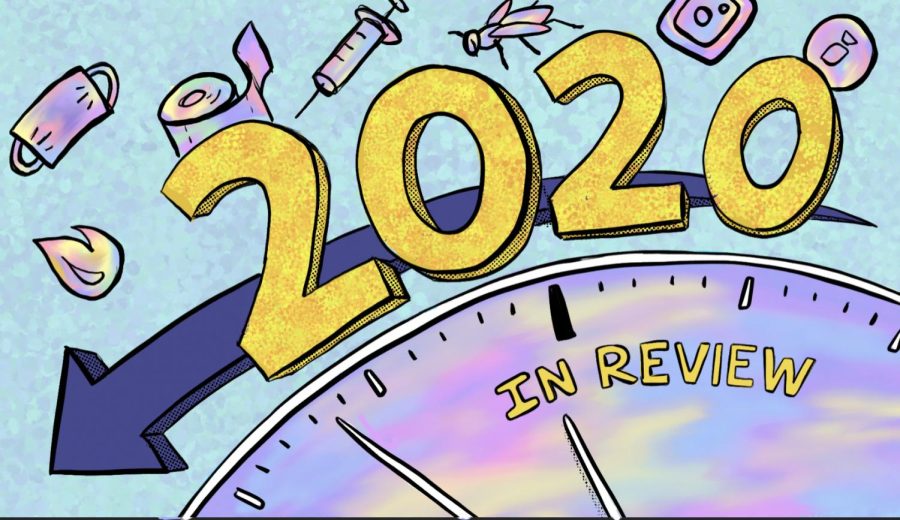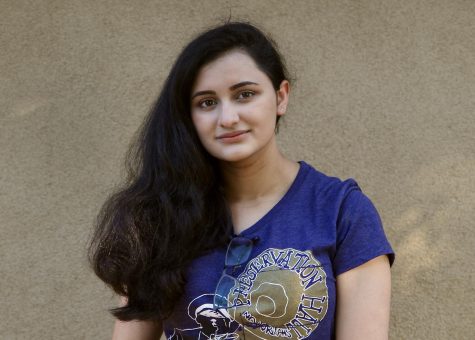The year that felt like a decade: 2020 in review
Graphic illustration by Elena Williams
As the year comes to a close, we look back on 12 of the weirdest consecutive months on record, in the hopes that none of this will ever happen again.
December 9, 2020
“3…2…1…Happy New Year! 2020’s going to be a year to remember.”
From murder hornets and impeachment trials to nonstop wildfires and the election of the century, 2020 has definitely earned its place in the history books. Oh, and did we mention the global pandemic? Let’s recap.
Wildfires in Australia
On the second day of the new year, Australia called its third state of emergency as brush fires ravaged the country, claiming the lives of 34 people. An estimated three billion animals were killed or displaced, despite fundraising efforts from around the globe.
Some studies have linked these wildfires to climate change, estimating that human-caused global warming increased the chances wildfires would occur by 30 percent. It’s possible that this forebode not only the subsequent disasters of 2020, but also more climate-induced catastrophes going forward.
Death of Qasem Soleimani
Remember those World War III jokes? Ah, quainter times.
On Jan. 3, President Donald Trump ordered a drone strike, killing Iranian major general Qasem Soleimani, stating that it was necessary to deter an “imminent attack,” and fueling tensions that had been rising since Trump’s withdrawal from the 2015 Iran nuclear deal. Some, including U.N. officials, questioned whether the attack complied with international law. What we all remember most, however, are the WWIII memes that predicted conflict as a result of the assassination. Luckily, no third world war resulted—if only because we were soon occupied by other catastrophes.
Kobe and Gigi Bryant’s death
On Jan. 26, basketball legend Kobe Bryant, his 13-year-old daughter Gianna and seven others passed away in a helicopter crash in Calabasas, California. Fans from around the world mourned a shocking and untimely death, and several NBA players and sports stars honored him in their subsequent games.
President Trump’s impeachment
In December 2019, the House of Representatives impeached President Trump after an inquiry alleged that Trump solicited campaign assistance from the Ukrainian president and obstructed justice by interfering with the House inquiry process. During the trial that followed in January, the Senate heard no witnesses, subpoenaed no documents and voted almost entirely down party lines, ultimately acquitting the President. Trump later fired the witnesses, Ambassador Gordon Sondland and Army lieutenant colonel Alexander Vindman, who testified against him.
Yes, that happened this year. If you’re like us, you will remember this as being around the time that you started noticing an unsettling trend in 2020.
The beginning of COVID-19 closures
In the almost three months since we had known about the coronavirus, the realization of its implications slowly set in. First, it was a virus that seemed to be localized on the other side of the world; then, it started popping up in small pockets on each continent; all of a sudden, the announcement came that school would be closing—first for three weeks, then for two months, then the rest of the school year and then the first semester of the next. Disinformation swirled—was it a deadly plague or no worse than the flu? Did mask mandates violate constitutional rights, or were they commonsense public health policies? Did injecting bleach help? Was March 2020 officially the longest recorded month in human history? All we know is that, within a few weeks, the phrase “unprecedented times” became the most overused in the English language. Let’s all just agree to never say it again after this is over.
Hand sanitizer, toilet paper, disinfectant wipes—oh my!
The panic that came with the COVID-19 lockdown sparked grocery store and convenience store raids across the country as people stocked up on hand sanitizer, toilet paper and disinfectant wipes, in that order. Toilet paper sold out everywhere, and latecomers were left with none.
Killing of George Floyd and protests following it
Black Lives Matter (BLM) protesters took to the streets when George Floyd was killed at the hands of Minneapolis police on May 25. The protesters demanded justice for his family, hoping to see the officers responsible held accountable and charged. The BLM movement began to gain traction again, gripping the attention of the entire nation and sparking counter protests by All Lives Matter and Blue Lives Matter groups. Awareness and anger grew around the case of Breonna Taylor, a Black woman who was shot and killed by police in her apartment in Louisville, Kentucky on March 13. “Say her name” and “All Cops Are Bastards” became common slogans among BLM supporters as they fought to defund the police and reform the justice system.
Murder hornets
Also known as Asian giant hornets, murder hornets have toxic venom in their stinger that, with a series of stings, can be fatal. Though they have long existed in Asia, these insects have only recently been seen on this side of the Pacific Ocean. Despite reassurance from experts that the hornets would not pose a great risk to the public, anxiety grew on social media, while others responded with disbelief that this was still news in 2020. I think we can all agree that this is a problem for 2050.
Social media activism
GenerationZ TikTok users and K-pop fans artificially inflated attendance expectations at Trump’s Tulsa rally by buying seats they did not intend to fill. Instagram users posted black squares on June 2 to amplify Black voices. Reposts filled Facebook and Instagram stories. The internet allowed communities to bring attention to issues immediately, often helping to raise support for groups and individuals—but the rapid spread of news online also contributed to widespread disinformation and online conflict. Reactions to the social media activism wave differed; some believed it was a quick and effective way to spread information, while others believed too many were becoming “performative activists,” or people who claim support for a cause in search of personal validation rather than real change.
West coast wildfires
In early September, California’s now-annual wildfires started burning in Southern California, starting fire season early with a series of lightning strikes. By late October, the fires had spread to 12 different states and burnt more than eight million acres. 2020 was officially straight fire—but not the cool kind.
John Lewis’s death
Congressman John Lewis, civil rights leader and Georgia representative, passed away on July 17 at the age of 80. Lewis was one of the foremost student leaders in the 60’s civil rights movement, helping organize the Freedom Rides, lunch counter sit-ins and March on Washington. On the day of his funeral, the New York Times published an op-ed he had written before his death in which he urged the new generation of young people to continue the fight for racial justice and keep making “good trouble.”
Start of remote learning in the fall
A three-week break turned into a two and a half month break, which turned into a rest-of-the-school-year break and then a summer-at-home-and-next-year-online-too “break.” COVID-19 forced schools to shut down unexpectedly in March 2020, and many administrators and teachers were unprepared for the change, making online learning a struggle. However, when fall came around and the 2020-21 school year began, many schools implemented a new version of remote learning. School administrators and teachers had the summer to prepare, so they found online platforms to upload assignments effectively and even conduct virtual labs. Lynbrook teachers started using Schoology consistently, and students were given school-sponsored educational resources such as Creative Cloud subscriptions and premium Zoom accounts. Although school-from-home has certainly been difficult, students, teachers and parents are striving to make it work until a return to campus is safe.
Ruth Bader Ginsburg’s death
On Sept. 18, the country lost another national hero when Supreme Court justice and feminist icon Ruth Bader Ginsberg passed away from complications from pancreatic cancer. Justice Ginsberg’s death was deeply painful for many Americans. The push to confirm a new justice to take her place began just hours after the news of her death broke, despite her dying wish that another justice not be confirmed until after the winner of the 2020 election took office.
Amy Coney Barett confirmed to the Supreme Court
After Ginsburg’s passing, Trump nominated Justice Amy Coney Barrett to take her place. Her eventual confirmation meant there would be a 6-3 conservative majority in the Supreme Court, which may lead to the overturning of Roe v. Wade and decisions limiting transgender rights. During the confirmation process, conflict between Democrats and Republicans centered around the inconsistencies between Ginsburg’s passing and that of Justice Antonin Scalia in 2016, nine months before the election that would result in Donald Trump’s presidency.
Democrats asserted that it was hypocritical of Republicans to push for Barrett’s confirmation when they had blocked President Obama’s nominee in 2016, claiming Scalia’s death was too close to the election and that the balance of the court should be left up to the people. Republicans refuted this argument by pointing out a key difference: in 2020, the Senate majority aligned with the president’s party, while in 2016, the majority of the Senate had not “pledged to work with and support the president’s agenda,” as Senate Majority Leader Mitch McConnell said in his statement. The battle that ensued over the confirmation of Barrett while the wound of Ginsburg’s loss was still raw amplified the pain for many on both sides of the aisle. She was ultimately confirmed to the Supreme Court on Oct. 27 by a 52-48 vote in the Senate.
Donald Trump contracted COVID-19
“No one is above the laws of the land — even the president.” That’s a sentence we hear often in reference to our democracy. Here’s another, for your consideration: “No one is above the laws of nature—even the president. (Obviously.)”
On Oct. 2, President Trump announced that he had tested positive for COVID-19, along with First Lady Melania Trump and several other White House officials. He was sent to Walter Reed Hospital for non-FDA approved antibody treatment and recovered within a few days The incident reminded Americans that no one, no matter the resources they have at their disposal, is safe from contracting the virus. It doesn’t hurt to have the best medical care in the country, though.
Debates, debates, debates
With the whole country watching, Donald Trump and Joe Biden took the stage at the first presidential debate on Sept. 29, and it immediately devolved into a kindergarten sandbox fight. Moderator Chris Wallace may as well have stayed home for all it mattered. The New York Times called the debate “chaotic”; Fox News “full of attacks on personal terms”; CNN “a hot mess, inside a dumpster fire, inside a train wreck.” Finally, something we can all agree on.
On Oct. 7 came the vice presidential debate between Mike Pence and Kamala Harris. (Seriously, was anyone still undecided by then?) After the catastrophic last debate, Pence and Harris offered viewers a taste of refreshing boredom in a highly regular exchange. It only briefly became interesting when a fly landed on Pence’s head, resulting in widespread memes that prompted the Biden-Harris campaign to sell “Truth Over Flies” fly swatters on its website. The second presidential debate was scheduled to take place on Oct. 15. Coronavirus, however, had other plans. In the days leading up the event, Trump was hospitalized for COVID-19, and Biden objected to an in-person debate for safety reasons. Trump, in turn, refused to take part in a virtual debate, calling it a “waste of time.” Biden then recused himself from the debate entirely and planned a televised town hall instead. Not to be outdone, Trump decided to schedule his own at the same time, forcing viewers to choose between the candidates and furthering the established sense of national divide.
Viewers were left pleasantly surprised at the calm and on-topic final debate on Oct. 22, which contrasted noticeably with the first presidential debate. Perhaps the difference was the result of the new rule that allowed the moderator to mute microphones. (Fans of partisan bickering, fear not; there’s plenty more of that to come.)
National election
The 2020 election will certainly be known as a unique point in our history. U.S. voters elected Biden as president with the highest voter turnout in history, making Biden the president-elect with the most votes ever, more than 80 million. Unlike on a typical election day, which, for many people, involves curling up on the couch with family and tuning into election coverage for the night, 2020 voters were left not knowing a definite winner on Nov. 3. Mail-in ballots in crucial swing states continued to be counted for several days, until official sources finally called the election for Biden on Nov. 8. He ended up flipping swing states Pennsylvania, Wisconsin, Michigan, Georgia and Arizona for the victory. During the long wait for results, CNN anchor John King and NBC data expert Steve Kornacki became overnight internet sensations as they stayed on air for days straight, zooming in and out on counties across the U.S. on their smartboards and explaining countless possible scenarios.
In addition to the presidential race, the Democrats held onto their majority in the House, although the margin narrowed, and the Senate majority remained undecided. The Republicans currently hold 50 seats, while the Democrats have 48, and Georgia’s two seats are going to runoffs in January.
Of course, even as all disputed states have certified their results in favor of Biden and Trump’s campaign continues to fail in its legal challenges, the country remains divided over whether what happened actually happened.
Vaccines? Maybe?
Pfizer, AstraZeneca and Moderna have announced vaccine candidates, prompting the biggest collective sigh of relief shared around the world. Though Pfizer had originally offered large quantities of the vaccine to the U.S., the Trump administration declined them for whatever reason, and they were sent to other countries. Despite the U.S.’s potential vaccine shortage, the vaccine marks what might be the beginning of the end of the pandemic—for other countries at least. We’ll have to wait for it to be approved by the FDA, manufactured for the entire population, distributed to all the billions of people who need it, given to enough people to achieve herd immunity and…
Happy New Year!
Last year, we wished for excitement and adventure in 2020. Suffice it to say that neither of those is on our wish list for 2021. To our dear readers, we wish you the most boring and ordinary of years in 2021. We wish you monotony; we wish you tedium; we wish you a year completely devoid of new experiences. May your days be dull and repetitive, and may you go forth into a world filled with mind-numbing routine and familiarity. 2020 has been one extraordinary ride, but we are all ready to leave it behind us and move forward into a better—or, at least, less outrageous—year ahead.



































































